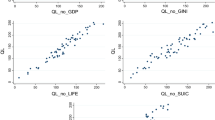There are two kinds of people in the world: those who divide the world into two kinds of people, and those who don’t.
—Robert Benchley.
Abstract
The paper analyzes how the United Nations Development Programme, the World Bank, the International Monetary Fund and the World Trade Organization classify countries based on their level of development. These systems are found lacking in clarity with regard to their underlying rationale. The paper argues that a country classification system based on a transparent, data-driven methodology is preferable to one based on judgment or ad hoc rules. Such an alternative methodology is developed and used to construct classification systems using a variety of proxies for development attainment. The methodology provides a way to construct a linear approximation of a Lorenz curve such that the difference between the linear approximation and the actual Lorenz curve is minimized. The linear segments represent different categories of countries (e.g., low development and high development countries). The methodology has wider applicability; it can be used whenever there is a need to construct a classification system of relatively few categories from a large heterogeneous sample.


Similar content being viewed by others
Notes
Twenty-three years hence similar language is still in use in the World Bank. On page xxiii in the 2012 WDI, one learns that “low- and middle-income economies are sometimes referred to as developing economies. The term is used for convenience; it is not intended to imply that all economies in the group are experiencing similar development or that other economies have reached a preferred or final stage of development.”
This section draws on information available on WTO’s web-site (WTO.org) supplemented with direct inquiry of WTO staff.
Lifetime income is defined as income times longevity. The variable shows the expected lifetime income of a newborn at a 0 % discount rate under the assumption of no future income growth. The use of a positive discount rate will shift the measure more toward a simple per capita income measure.
References
Atkinson, A. B. (1970). On the measurement of inequality. Journal of Economic Theory, 2, 244–263.
Becker, G. S., Philipson, T. J., & Soares, R. R. (2005). The quantity and quality of life and the evolution of world inequality. American Economic Review, 95(1), 277–291.
Bourguignon, F., & Morrison, C. (2002). Inequality among the world citizens: 1820–1992. American Economic Review, 92(4), 727–744.
Dalton, H. (1920). The measurement of the inequality of incomes. The Economic Journal, 30(119), 348–361.
de Vries, M. G. (1985). The International Monetary Fund 1972–78: Cooperation on trial. Washington: International Monetary Fund.
International Monetary Fund. World Economic Outlook (Washington, D.C., various issues).
IMF (2010) Selected Decisions and Selected Documents of the International Monetary Fund, Thirty-fifth Issue (Washington).
Nielsen, L. (2011) Classifications of Countries Based on Their Level of Development: How it is Done and How it Could be Done. IMF Working Paper 11/31.
Pearson, L. B., et al. (1969). Partners in development: Report of the commission on international development. New York: Praeger.
Quah, D. T. (1996). Twin peaks: Growth and convergence in models of distribution dynamics. Economic Journal, 106, 1045–1055.
Quah, D. T. (1997). Empirics for growth and distribution: Stratification, polarization, and convergence clubs. Journal of Economic Growth, 2, 27–59.
Pritchett, L. (1997). Divergence, big time (pp. 3–17). XI: Journal of Economics Perspectives.
Sala-i-Martin, X. (1996). Regional cohesion: Evidence an theories of regional growth and convergence. European Economic Review, 40, 1325–1352.
Sen, A. (1999). Development as freedom. New York: Random House.
United Nations Development Programme. Human development report. New York: Oxford University Press, various issues).
World Bank. World Development Indicators (Washington, D.C., various issues).
Acknowledgments
Special thanks are due to Russell Kincaid who provided extensive commentary on earlier drafts. I would also like to thank Pedro Conceicao, Sarwat Jahan, Namsuk Kim, Heloisa Marone, Samar Maziad, Prachi Mishra, Catherine Pattillo, Barry Potter, Martin Ravallion, Luca Ricci, Francisco Rodriguez, Mick Silver, Eric Swanson, and Yanchun Zhang for useful comments and inputs. The usual disclaimer applies.
Author information
Authors and Affiliations
Corresponding author
Appendices
Appendix 1
The sufficient second order conditions are that
These conditions are met because \( L(x) \) is strictly convex. An additional necessary second order condition is that the determinant of the Hessian matrix is non-negative:
This is equivalent to evaluating the sign of the following expression:
When the first order conditions are satisfied, the second derivatives are given by:
Therefore, the first part of the expression can be rewritten as follows:
As the first part of the expression is equal to the second part, the determinant of the Hessian matrix is zero, and all necessary second order conditions are met. The corner solution is when \( x_{0} = 0 \wedge x_{1} = 1 \). That point, \( E_{3} (0,1) = E_{1} \), maximizes the error. The interior point where the first order conditions are met is therefore a minimum.
Appendix 2
In a taxonomy with N categories, the error term associated with that taxonomy consists of the sum of N triangles and N−1 rectangles less the area under the Lorenz curve. The areas of the triangles are as follows:
Therefore, the sum of the areas of the triangles is
The areas of the \( N - 1 \) rectangles are as follows:
Therefore, the sum of the areas of the rectangles is
The general form for the error term for n categories is therefore given as:
By defining \( x_{n - 1} \equiv L(x_{n - 1} ) \equiv 1, \) and recalling the definition of \( E_{1} , \) the following more compact formulation obtains:
The first order conditions are as follows:
Rights and permissions
About this article
Cite this article
Nielsen, L. How to Classify Countries Based on Their Level of Development. Soc Indic Res 114, 1087–1107 (2013). https://doi.org/10.1007/s11205-012-0191-9
Accepted:
Published:
Issue Date:
DOI: https://doi.org/10.1007/s11205-012-0191-9




